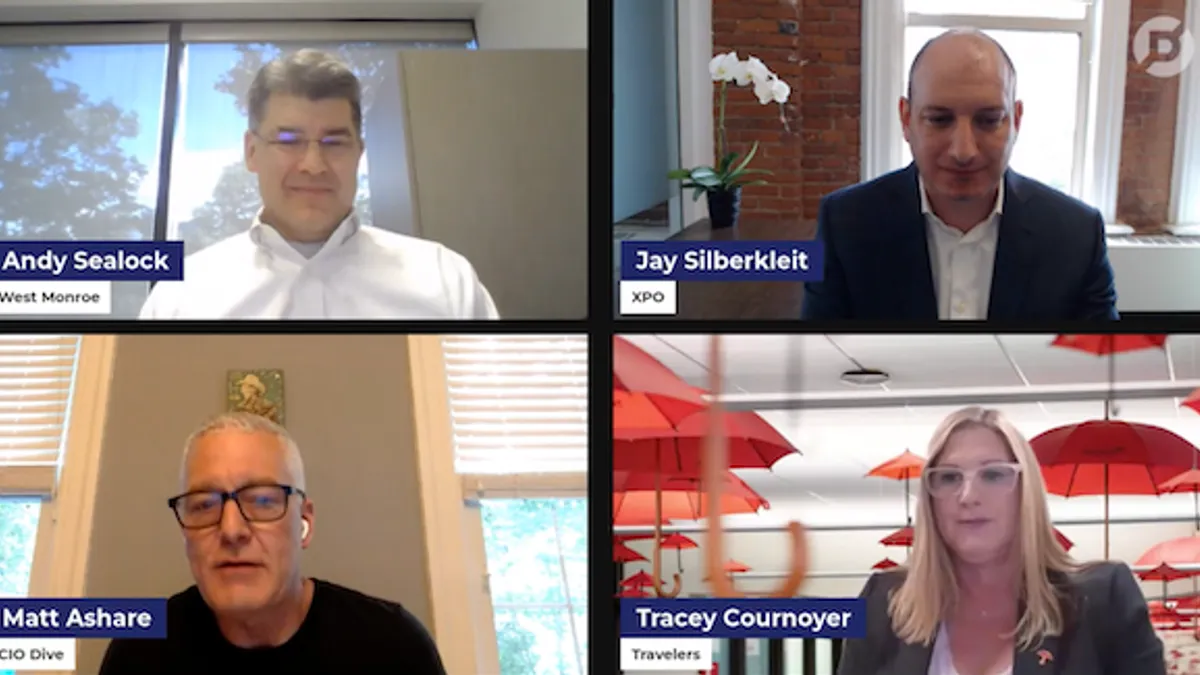Cloud migrations have become a rite of passage for the modern organization.
“We really do see an entire spectrum of where enterprises are in their cloud journey,” Andy Sealock, senior partner, advisory and transformation at consulting firm West Monroe, said during a CIO Dive virtual event Wednesday. “But almost all of them, I can’t think of any examples that aren’t, are at least experimenting in the cloud now and are developing roadmaps for cloud.”
Tracy Cournoyer, VP and CIO, bond and specialty insurance at Travelers, is supporting a cloud migration that commenced in 2019. The insurer has a one-provider strategy to ensure Cournoyer and her team maintain expertise in Travelers’ cloud of choice.
“For us to make sure we accelerated our journey, it was important for all of our architects and engineers to understand the one cloud,” Cournoyer said during a CIO Dive virtual event. “If we had to stand up multiple clouds, it would have taken much longer in our journey.”
Now midway through the migration process with data analytics operations in cloud, the company is charting a path forward by evaluating legacy applications, drawing on what it has learned thus far.
AI and data analytics have been a major cloud selling point for Travelers. In one use case, the company captures imagery AI to process wildfire claims even before those affected are able to return to their homes, Cournoyer said.
Like Travelers, the freight transportation company XPO is using cloud to align technology with business strategy, finding ideal use cases while retaining flexibility.
Jay Silberkleit, CIO at XPO, is leaning on cloud to optimize the less-than-truckload business, a logistically complex operations that benefits from ML-driven data analytics.
One size does not fit all in cloud. Tech leaders have specific demands, such as better data visibility and the ability to scale innovation more seamlessly. They tailor cloud to the needs of their businesses.
“Cloud was really important for us as we started to migrate off of those legacy systems and modernize our technology stack,” Silberkleit said during a CIO Dive live event. “Now, we take a very pragmatic view; we’re very commercial about how we do it.”
Silberkleit balances the need to maintain systems and keep the business running with the continued need to innovate — a defining battle for CIOs.
“Having that cloud strategy allows us to scale, allows us to be agile, allows us to get that incremental benefit as we identify value propositions across our business and for our customers,” Silberkleit said.
Currently, XPO operates in a hybrid environment. The company is building out proprietary apps while retaining on-prem systems when there’s no value in moving to cloud yet. Its proprietary development mostly happens in Google Cloud, thanks to an existing partnership, but Silberkleit said the company taps other cloud providers when it makes sense to do so.
For companies feeling the weight of macroeconomic conditions, leaving some things on prem can make sense, Sealock said. Businesses can lose money, particularly with older legacy applications, if the IT teams simply lift and shift the workload to the cloud.
“There are certain legacy applications where there can be a pretty big lift upfront to refactor it so that it will run efficiently in the cloud,” Sealock said.
Traditional data centers, if run efficiently and at scale, "might be able to beat the individual price point for a given app of what you would be able to realize in the cloud,” Sealock said.














